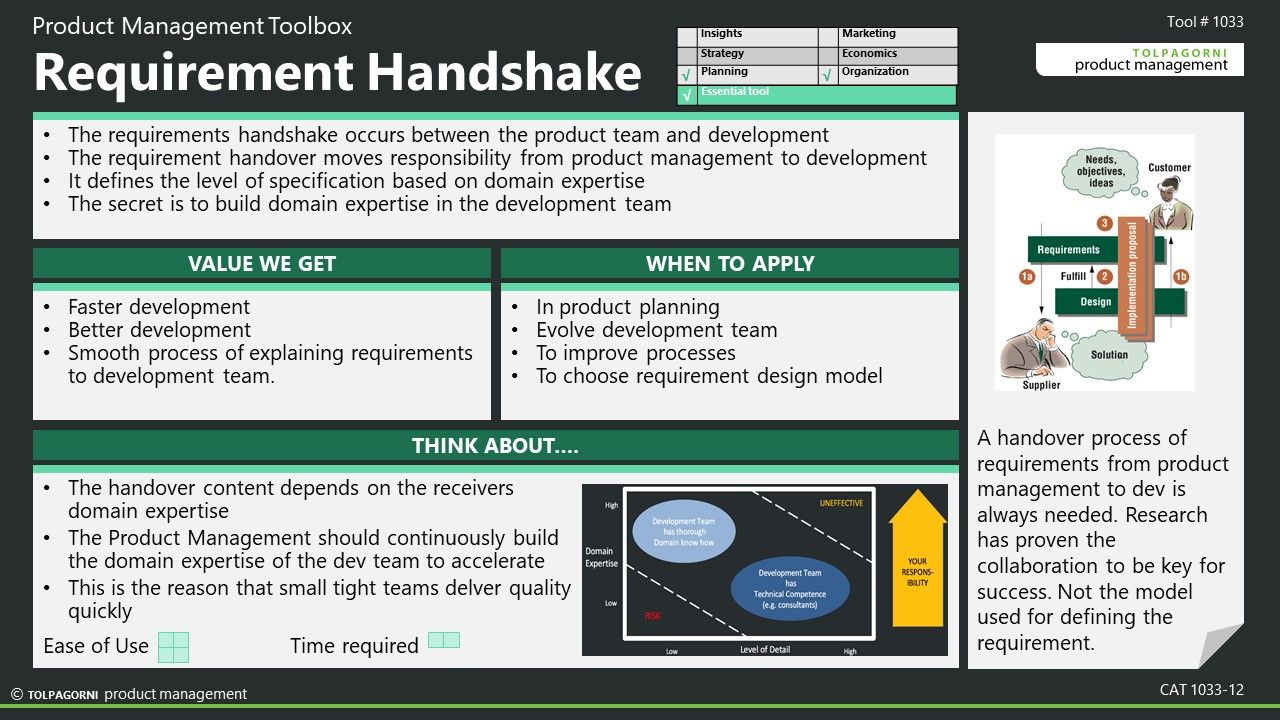Tool #32

Building domain expertise within your development team is the best investment you can ever make.
There are many models in how to handover requirements from product management to development. In agile environments, we often use "User Stories." In Stage-Gate environments, Market Requirement Documents (MRD) or Product Requirement Documents (PRD) are common (or at least used to be?).
If you work in a lean startup, we often use prototypes and beta designs to define the products. In the electronics industry, special languages have evolved to define the requirements. "Planguage" is a common language for the handover (used at Intel) and "EARS" was invented for handing over requirements at Rolls Royce. In some environments the test cases are defined as requirements (so-called test-driven development). We use the napkin version in some startups - we design it on a napkin and then hand it over to developers to develop it.
It is in the handover work we decide the success and define the cost of development. What models should be used? How do we decide upon the level of details in our user story? What does a great handover from Product Management to development look like? The context is, of course, important. If development mistakes are costly, the specification must be detailed. This is typical in electronics, firmware, or business-critical software. In these cases, we invest heavily in the writing of the requirement. The handover includes many details.
On the other hand, if we are working with a new entertainment app, we focus on speed and user testing. But there is more to guide us. One of the most intriguing areas in hand over is the interactions with- and the domain expertise of the development team. Research done by Professor Dr. Samuel Fricker, shows the importance of collaboration. He states that the collaboration between the product manager and the development team is the most critical part of qualitative implementation. This is one of the reasons that Scrum delivers great value.
Domain expertise is another important area. If you have skilled and experienced developers, the specifications can be done swiftly. On the other hand, if you have wonderful c++ -developers right out of school, you will need to create a very detailed specification for them. Hence, one of the best ways to improve handover between product management and development is to build domain expertise. This is the job of the product manager. Don't just tell the development team what to build; strengthen their understanding of the usage and the business context. That builds Domain expertise and speed in handover while keeping the quality in implementation.
The tool above shows the relationship between the level of details and domain expertise. It also identifies your responsibility as a product manager to build domain expertise.
Domain expertise will speed up development, create better products at a lower cost.
The User Stories, Personas, Prototypes are all great ways to build domain expertise.
Attached is the tool Requirement Handshake.
Empty space, drag to resize
Empty space, drag to resize
Oops, looks like you're not logged in!
Log in in order to access the tool!
Copyright © 2023 ProductBeats AB

Get The Program Brochure
Submit the form below to have The Program Brochure delivered to your inbox
The title of the notification
The descriptive text of the notification

